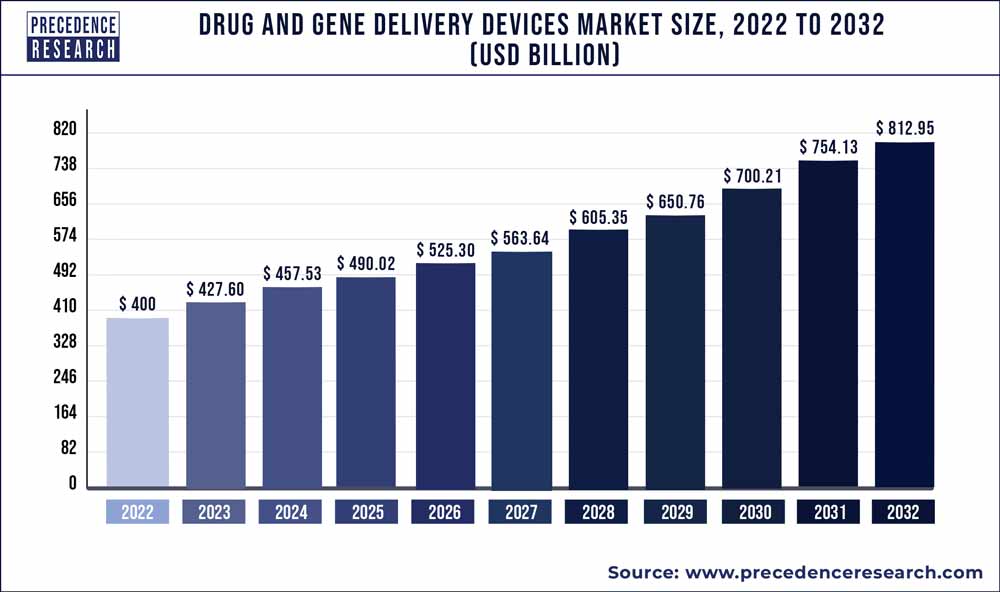The global drug and gene delivery devices market size reached USD 400 billion in 2022 and is projected to hit USD 812.95 billion by 2032 with a CAGR of 7.40% from 2023 to 2032.
The global drug and gene delivery devices market is primarily driven by the rising prevalence of various chronic diseases such as cancer, diabetes, and cardiovascular diseases among the global population. The rapid growth of the biopharmaceuticals industry resulted in the development of various therapeutics and gene therapeutics that can effectively treat various chronic diseases and genetic diseases. The rising adoption of such drugs among the population is boosting the growth of the global drug and gene delivery devices market.
Furthermore, the rising investments by the market players in the research and development of the drug delivery systems are fostering the market growth. The technological advancements are providing easy to use and convenient administration of drugs through various roots, which is expected to drive the drug and gene delivery devices market across the globe.
Get Report Sample Copy OR Any Customization Requirement@ https://www.precedenceresearch.com/sample/1388
North America dominated the global drug and gene delivery devices market in 2022. The increased number of patients suffering from chronic diseases in the US has fostered the market growth in the region. According to a study, around 60% of the US population is suffering from at least one chronic diseases. Furthermore, the higher adoption rate of technologically advanced and innovative therapeutics among the North American population is spurring the demand for the drug and gene delivery devices. The rapidly growing biopharmaceutical industry is another significant driver of the market.
Asia Pacific is estimated to be the fastest-growing market during the forecast period. The presence of several top biopharmaceutical companies in the nations like India, China, and South Korea is propelling the market growth. The presence of huge population and rising prevalence of chronic diseases among the population is a major factor that is expected to drive the growth of the drug and gene delivery devices market in the region. Furthermore, the rising popularity of the personalized medicines among the population to treat genetic disorder may have a positive impact on the market. The rapid industrialization in the region is resulting in pollution that further propels the number of respiratory diseases among the population. Therefore, the rising number of disease due to the rising pollution levels in the region is expected to offer lucrative growth opportunities to the market players in the upcoming future.
The rising number of approvals for the newly developed therapeutics across the globe is expected to have a positive impact on the market. The major approving authorities such as FDA and EMA are very much active in monitoring the clinical trials of various medicines and diagnostic methods.
The stringent government regulations pertaining the drug and gene delivery devices and the infections and injuries caused by the injectable are the two major restraining factors that may hamper the growth of the global drug and gene delivery devices market during the forecast period.
Report Scope of the Drug and Gene Delivery Devices Market
| Report Highlights | Details |
| Market Size | USD 812.95 Billion by 2032 |
| Growth Rate | CAGR of 7.40% From 2023 to 2032 |
| Largest Market | North America |
| Fastest Growing Market | Asia Pacific |
| Base Year | 2022 |
| Forecast Period | 2023 to 2032 |
| Segments Covered | Delivery Type, Method, Vector, Region |
| Companies Mentioned | Pfizer, Inc., F. Hoffmann-La Roche Ltd, Johnson and Johnson Private Ltd, Novartis AG, Bayer AG, Becton, Dickinson and Company, Uniqure NV |
Based on the delivery type, the injectable is estimated to be the most opportunistic segment during the forecast period. This can be attributed to the development and rising popularity of various injectable such as pen-injectors, self-injectors, and auto-injectors that emerged as a result of the technological advancements in the market. The rising number of diabetic population who needs to inject insulin as a diabetes management measure is expected to drive the growth of this segment. Moreover, the convenience associated with the injectable may boost the adoption of the injectable in the forthcoming years.
Based on the method, the in situ segment dominated the market in 2022. This can be attributed to the certain advantages associated with the in situ method such as low complication in fabrication and ease of drug administration. Moreover, the majority of the drugs that are currently used follows the in situ method.
Based on the vector, the viral vector segment dominated the market in 2022. This is due to the increased usage of the viral vectors for the majority of the clinical trials. Moreover, the rising prevalence of genetic disorders and chronic diseases among the global population is further fueling the segment growth. The extensive use of the viral vectors in the development of drugs and gene therapies has significantly contributed towards the growth of the segment in the past.
Based on the delivery type, the injectable is estimated to be the most opportunistic segment during the forecast period. This can be attributed to the development and rising popularity of various injectable such as pen-injectors, self-injectors, and auto-injectors that emerged as a result of the technological advancements in the market. The rising number of diabetic population who needs to inject insulin as a diabetes management measure is expected to drive the growth of this segment. Moreover, the convenience associated with the injectable may boost the adoption of the injectable in the forthcoming years.
Based on the method, the in situ segment dominated the market in 2022. This can be attributed to the certain advantages associated with the in situ method such as low complication in fabrication and ease of drug administration. Moreover, the majority of the drugs that are currently used follows the in situ method.
Based on the vector, the viral vector segment dominated the market in 2022. This is due to the increased usage of the viral vectors for the majority of the clinical trials. Moreover, the rising prevalence of genetic disorders and chronic diseases among the global population is further fueling the segment growth. The extensive use of the viral vectors in the development of drugs and gene therapies has significantly contributed towards the growth of the segment in the past.
Read Also: Life Science Reagents Market Size to Hit USD 90.05 Bn By 2032
Some of the prominent players in the global drug and gene delivery devices market include:
- Pfizer, Inc.
- F. Hoffmann-La Roche Ltd
- Johnson and Johnson Private Ltd
- Novartis AG
- Bayer AG
- Becton, Dickinson and Company
- Uniqure NV
Segments Covered in the Report
By Delivery Type
- Oral
- Ocular
- Inhalation
- Nasal
- Injectable
- Transdermal
- Topical
By Method
- In Situ
- Ex Vivo
By Vector
- Viral Vector
- Non-Viral Vector
By Geography
- North America
- U.S.
- Canada
- Europe
- U.K.
- Germany
- France
- Asia Pacific
- China
- India
- Japan
- South Korea
- Rest of the World
Contact Us:
Mr. Alex
Sales Manager
Call: +1 9197 992 333
Email: sales@precedenceresearch.com
Web: https://www.precedenceresearch.com
Blog: https://www.expresswebwire.com/
Blog: https://www.uswebwire.com/
Blog: https://www.dailytechbulletin.com/
Blog: https://www.autoindustrybulletin.com/
- Esoteric Testing Market Size to Hit USD 75.54 Bn by 2032 - July 17, 2024
- mRNA Therapeutics Market Size to Surpass USD 39.99 Bn By 2033 - July 17, 2024
- Acne Treatment Market Size to Hit USD 15.86 Bn by 2033 - July 17, 2024


